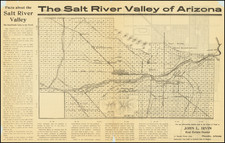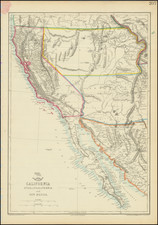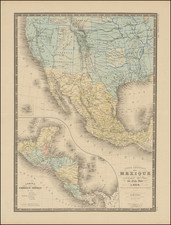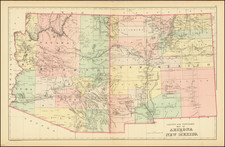The First Separately Published Atlas Map of Arizona Territory
Rare 1875 map of Arizona Territory, published by George Cram in Chicago
The map includes significant details around the Phoenix area of Maricopa County, including the results of the earliest township surveys in the region.
The route of the proposed Texas Pacific Railway is shown. In later editions, the route has been removed east of Gila Bend and reduced to a single line, rather than the bolder line shown here. A third prospective railroad route is shown further north, crossing south into the Mojave Desert near Needles.
Cram's map of Arizona Territory is one of the earliest separately published maps of Arizona, having been issued separately beginning in 1875 and in the rare pre-1880 editions of Cram's atlas. The first edition of the map included a decorative border. The map shows early township surveys, roads, 2 proposed Railroad routes, mountains, rivers, forts, Indian Reservations and other details.
A fine example of this rare early map of Arizona Territory.
George F. Cram (1842-1928), or George Franklin Cram, was an American mapmaker and businessman. During the Civil War, Cram served under General William Tecumseh Sherman and participated in his March to the Sea. His letters of that time are now important sources for historians of the Civil War. In 1867, Cram and his uncle, Rufus Blanchard, began the company known by their names in Evanston, Illinois.
Two years later, Cram became sole proprietor and the company was henceforth known as George F. Cram Co. Specializing in atlases, Cram was one of the first American companies to publish a world atlas. One of their most famous products was the Unrivaled Atlas of the World, in print from the 1880s to the 1950s.
Cram died in 1928, seven years after he had merged the business with that of a customer, E.A. Peterson. The new company still bore Cram’s name. Four years later, the Cram Company began to make globes, a branch of the business that would continue until 2012, when the company ceased to operate. For the final several decades of the company’s existence it was controlled by the Douthit family, who sold it just before the company was shuttered.












![[Las Vegas / Northwestern Arizona / Colorado River] Map Showing Routes of the River and Land Parties Engaged in Exploring the Grand Cañon of the Colorado. . . 1871](https://storage.googleapis.com/raremaps/img/small/89971.jpg)



![[ The First SCORE Off-Road Desert Race Course Maps ] Mickey Thompson's SCORE Parker 400 -- Arizona Side and California Side](https://storage.googleapis.com/raremaps/img/small/97070.jpg)